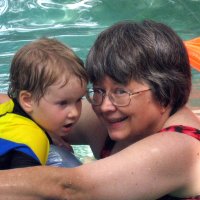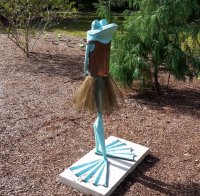Okay, Faithful Readers. I'm listening to an instructional video on using PaintShop Pro, and the instructor interrupts his teaching to give a lecture on how important it is NOT to geotag any photos in or near your home, because "you don't want other people to be able to find out where you live. It's not safe." Huh? Has he never heard of a telephone book? And now with the Internet it's ridiculously easy to find out that kind of information. Where you live. What taxes you pay. What you paid for your house. Your birthday. Your family members. Your political donations. If you're lucky enough to be a state employee in Florida, your salary. Google will even show you the flowers in my front yard—at least what they looked like at some point in the past. So what if someone can tell from my photograph where it was taken? If anyone wants to do something nefarious, they have plenty of other resources.
I find the feature on my camera that detects and saves location data to be extremely useful. I'm undertaking the incredibly, ridiculously challenging project of organizing many years' worth of photographs, and the only thing that annoys me about embedded GPS data is that it's not available on most of my photos. Even my phone camera, which is the first I've had with GPS information, only began recording that data once I found and enabled the feature.
Privacy has always been very important to me. This may seem odd coming from someone who writes a blog that is shared with the world, but I still consider myself a private person. "Private" doesn't mean I don't share, any more than "introvert" means I don't like people. To me, it means (1) I choose what I share and with whom, and (2) I accept that some things are going to be available to others whether I choose to share them or not. In facing the latter case, I have come to realize that I can either shrink back in fear, or I can accept the small additional risk for the sake of the benefits that have come with new technology and new situations.
My blog audience my not be large, but I know it's diverse, with people everywhere on the privacy spectrum. So I'll ask: What's your take on geocoded photos? Do you use that feature? If you don't, is it because you don't find a need for it, or because, like my photo software instructor, you think it's dangerous? If you are worried about safety, what advantage do you think it gives criminals that they couldn't easily get elsewhere?
 Malestrom: Manhood Swept Into the Currents of a Changing World by Carolyn Custis James (Zondervan, 2015)
Malestrom: Manhood Swept Into the Currents of a Changing World by Carolyn Custis James (Zondervan, 2015)
Malestrom is the fifth of Carolyn Custis James' books I have read and reviewed. (Most recently, Half the Church; you can find links to my other reviews there.) It's similar in style to her other books, which is both good and bad. Actually, I'm getting a little tired of that style, and of her confidence that she has discerned the feelings and motivations of Biblical characters. Trivially, may I say again how much I dislike questions at the end of the chapters? And what was she thinking with the title? I like wordplay as much as anyone, but we didn't need another excuse to be confused about the spelling of "maelstrom."
Okay, whining over. The great thing about Carolyn James is that she is an intelligent, seminary-trained, Christian woman who focuses all four of those attributes on questions that the church has not done well at answering.
Such as, What have we done to our men? As society has redefined what it means to be a woman, and what roles women can successfully fill, has that changed what it means to be a man? Has the cultural definition of manhood ever been satisfactory? How can we help our boys to become men when we don't even know what a man is supposed to be?
Not that James provides any down-to-earth, practical answers; she herself states that she reached the end of the book with more questions than when she started. But she has erected a framework on which to build, and offers several fresh insights to assist with that labor.
Here is my take on that framework:
- The purpose and role of all human beings, male and female, is to be—in life, in action, in relationship—the Image of God that they are.
- The Image of God cannot be revealed without both male and female. Not male and female individually, but "male and female" together.
- There's an important blank space at the beginning of Genesis. We see Creation, we see the Fall—what we don't see is how life and purpose were fleshed out for human beings in the time between those events.
- One of the tragic consequences of the Fall was the near-universal development of patriarchical systems of power—the Malestrom—which have pitted men not only against women, but also against other men in a scramble to be at the top of the power pyramid.
- Just because God worked through a patriarchical system to reveal himself and bring about restoration of his image-bearers, that doesn't imply the system itself was good. In many ways the history of God's interventions is a history of exceptions to the rules of patriarchy, especially once Jesus comes on the scene.
- Jesus is the true Image of God, and the ultimate revelation of the "missing chapter" in Genesis. He is therefore also the truest and best example of what it means to be a man. (Or a woman, for that matter, but Malestrom is largely about men. Women are covered in James' other books.)
You may not agree with all of James' conclusions. You may groan for less theory and more practice in her writings. I'm with you on both counts. But that doesn't change the fact that Carolyn Custis James is a vital voice in the Church today. She's asking important questions, providing new insights, and challenging us to consider how well our assumptions, our traditions, our words, our policies, and our actions reveal the Image of God to a world that's in a world of hurt.
And now for the quotations. They're pretty random, but that's where the sticky notes fell. (More)
I don't change my Facebook profile picture very often. Nor my cover photo, as evidenced by the fact that the current one is missing two grandchildren. In fact, I think I've only had three profile pictures since I joined Facebook in 2007. For a long time I used a version of our Sursum Corda Academy shield, which you see on the left-hand side of the banner at the top of this page. In 2014 I switched to this picture of Vivienne and Grandma swimming.
While I hate to replace that adorable moment, I think it's time I changed things up a little more often. Plus, I not could resist this photo of, um, myself with my cup of tea and my handsome prince, sitting on a bench at one of our favorite places: Leu Gardens, where we enjoy the flowers and others do all the work. (You can click on the images to see larger versions.)
The sculpture is by J.A. Cobb, and was part of a very enjoyable Ribbet the Exhibit display back in February.
And I'm not the only one in the family with a frog doppelgänger.
As I was preparing the last photo for posting, it occurred to me that it resembles something other than our granddaughter. Sure enough, I found this picture of Edgar Degas' Petite Danseuse de 14 Ans, from our trip to the St. Louis Art Museum. That had looked familiar in its turn; there's also a version at the Musée d'Orsay, in almost the exact pose as my frog picture. Now I don't know if it looked familiar in St. Louis because of the Orsay or Ribbit the Exhibit!
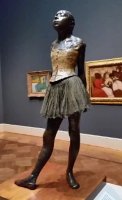 St. Louis
St. Louis  Paris (photo from the Musée d'Orsay website)
Paris (photo from the Musée d'Orsay website)
Permalink | Read 5975 times | Comments (1)
Category Just for Fun: [first] [previous] [next] [newest]
I like Bed Bath & Beyond. Their prices can be a little higher than at some places, but there are plenty of opportunities to get 20%-off coupons, and despite what the fine print might say, the coupons never expire. Most of all, here is the reason I love to buy small appliances at BBB:
Three years ago we bought a new toaster oven. I've been very happy with our choice, but early this year I noticed that one of the lower elements had developed a split.
The appliance still worked fine, so dealing with the problem dropped to the bottom of the to-do list.
However, I recently realized that the three-year warranty was about to expire, and the element, much to my surprise, had shown no sign of healing over the last seven months.
I wrote to Cuisenart, and I wrote to Bed Bath & Beyond. Both responded. Cuisenart's response was acceptable, but felt scripted and was not particularly helpful. I was beginning to wonder if it was worth the hassle and postage to return the unit. Maybe I should just fork over another $65 for a new toaster oven. If I were being cynical, I'd be pretty sure that's why warranty returns can be difficult.
But Bed Bath & Beyond's response pushed cynicism out the window. What it boiled down to: There's no limit on our return policy, just take it back to the store. Now that's what I call customer service.
So this afternoon I bundled up the toaster oven, not without a prayer of thanksgiving for three years of good service, and headed off to our local store. Thanks to Porter's meticulousness, I had the receipt, but since I wanted to do an even exchange I might not even have needed that. The cheerful and helpful sales clerk took the old toaster oven and sent me to pick out a new one. I was pleased to note that they are still carrying the same model, slightly updated, and for the same price as in 2012. The clerk made the exchange and sent me out of the store with a smile. Needless to say, I was smiling, too.
As far as I'm concerned, that's more than enough reason to shop at Bed Bath & Beyond. And to keep our receipts!
Permalink | Read 2266 times | Comments (0)
Category Everyday Life: [first] [previous] [next] [newest]
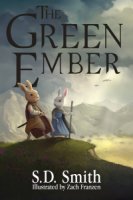

The Green Ember by S. D. Smith (Story Warren Books, 2014)
The Black Star of Kingston by S. D. Smith (Story Warren Books, 2015)
My place beside you, my blood for yours,
Till the Green Ember rises, or the end of the world!
The Green Ember stories began on a porch in West Virginia, with S. D. Smith and his young daughter watching rabbits cavort in their yard. Soon Smith began telling her stories about those rabbits and their adventures. Like rabbits, the stories multiplied. So did Smith's children (though not like rabbits) and they all loved the stories about #RabbitsWithSwords.
Finally, Smith decided to share his stories with a larger audience. If you want to know more, you can watch what apparently was their Kickstarter promo video. If it sounds a little funny in places, that's because for some reason the references to Kickstarter have been blanked out in this version.
The Green Ember is just a story. It's not a lesson, it's not a sneaky vehicle to teach you something. It's just a story. But I believe in the power of stories. — S. D. Smith
I also believe in the power of stories, whether from a book, a movie, a video game, or any other medium. Even at my age I must be careful what stories I let myself experience, because I'm so vulnerable to their effects. By now most of you know what's coming, my definition of a good book, slightly paraphrased: A good story inspires me to be a better person. These are good stories, not at all in a syrupy way, but shot through with reality, life, action, and beauty.
Yes, I realized I just used the term "reality" about a book with anthropomorphized animals.
It was a little jarring at first to wrap my head around the idea that the rabbits have both human and rabbit physical characteristics. That is, they are fully capable of using their front paws as hands (e.g. wielding swords, making stained glass windows, knitting), while their hind legs are rabbit-style powerful weapons. But it didn't take me long to get over it. (I wonder if it helped or hindered that I was at the same time reading Uncle Wiggily's Adventures. For the record, much as I respect the bunny rabbit gentleman, The Green Ember is 'way better.)
Let's see, what do I like about this book, other than its positive impact and the fact that I was immediately entranced and didn't want to put it down?
- The primary protagonist is a strong female character. I've mentioned before how I grew up with books that made me embarrassed to be a girl, and nearly always identified with the male characters instead. Here's a female character who can think, fight, nurture, worry, and push herself beyond her limits.
- This rabbit heroine is named Heather!
- The secondary protagonist, Pickett, is highly intelligent and mathematically talented, and his gifts don't make him a freak, but rather a valuable asset in the community.
- Due to his young age and the trauma in his life, Pickett has some dangerous emotional issues. The wisest rabbits in the community don't seek to make him "normal," but instead help him find healing through becoming more, not less, himself.
- This is very much a medieval rabbit world. They fight with swords and arrows—and feet and just a little bit of gunpowder. They make clothing by hand. Skills are learned through apprenticeship. Somehow chivalry and honor and high callings fit better in a medieval-themed world, as J.R.R. Tolkien and C.S. Lewis amply demonstrated. Even George Lucas peopled his high-tech future with swords and knights.
- The rabbit community values, supports, and praises excellence in every good endeavor, from cooking to fighting to building to storytelling. The end of the rabbits' world seems imminent, yet they emphasize the importance of the arts, and value doing the work of ordinary life extraordinarily well.
The ending of The Green Ember begs for a sequel, and I understand one is in the works. In the meantime, there's Smith's second book, The Black Star of Kingston. It's a distant-past prequel to The Green Ember, and definitely enjoyable to read in its own right. It's not quite as satisfying, mainly because it's much shorter, but also because the strong female characters are mostly missing. Perhaps even rabbit civilizations need to develop over time.
Thanks, Serina T. for recommending The Green Ember, and especially for letting me know about the amazon.com special when I could get the Kindle version for free. I'm hooked, of course, and bought The Black Star of Kingston at full price. Not that $3.99 is going to break the bank around here.
The Pope is getting all the publicity, but he isn't the only head of state visting a city of historic importance these days. Last week King Felipe VI and Queen Letizia of Spain came to St. Augustine, the oldest city in the United States. St. Augustine is celebrating its 450th anniversary, having been founded by the Spanish on September 8, 1565.
I'll bet the Spanish monarchs, cheered as they were by adoring crowds, didn't make nearly as much of a mess of the city as the visit of Pope Francis is expected to do to Philadelphia.
Permalink | Read 1857 times | Comments (2)
Category Random Musings: [first] [previous] [next] [newest]
This is my 100th blog post for this year, and I think it fitting to dedicate it to promoting another blog, just five months old but very promising: Blue Ocean Families.
Inspired by the business concept of Blue Ocean Strategy, the Blue Ocean Families team seeks to answer the question, How can we leave this frantic modern life and carve out a peaceful blue ocean for our families?
Blue Ocean Strategy: Don’t beat the competition, make it irrelevant.
The creators of Blue Ocean Strategy illustrate their idea by envisioning traditional markets as a bloody red ocean of cut-throat competition. They propose that businesses should leave this deadly environment and carve out untapped market space (i.e. a customer base nobody else is reaching). They call this unique market space a blue ocean and explain how to create one in any industry.
Blue Ocean Families: Turn the competition into community.
The red ocean is where we try to keep up with the Joneses and fight the mommy wars. A blue ocean family doesn’t follow the status quo, but celebrates and develops its uniqueness while living in community with other families.
Here are five of my favorite posts:
Can We Trust the Path of Learning that Our Kids Choose?
Support for Parents on the Road Less Traveled
The Cost of Creativity: 9 Reasons Why You Shouldn't Want Creative Kids
Learning to Eliminate: Cultural Context
Entertainment Rethink: Don't Forget Fun!
(It was hard to pick just five, but then I am biased. I suppose that in the interest of full disclosure, I should mention that the founder and primary author of Blue Ocean Families is my daughter. But that would be bragging.)
Picture the Blue Ocean. This peaceful haven is a place where just one family swims and where each family member can thrive. They have room and laughter, and time to explore and expand. They threaten no one because they chose to leave the Red Ocean and carve out space to make their very own Blue Ocean.
How do you create a Blue Ocean – a unique family culture – where each member has the freedom to thrive AND where success helps others rather than threatens them?
That’s the question I want to explore in this blog. It’s little more than a vision now, but if you find the idea intriguing, then please join me on my journey!
Ah, I knew there was a reason I didn't want to have Amazon's "1-Click" purchase button turned on. But when buying Kindle books, there's no choice. Tonight I was browsing their daily deals and, somehow, accidentally clicked on a "Buy now with 1-Click" button. I think the problem was related to the fact that something—my computer, Firefox, Norton, our ISP; I don't know the culprit—has been making the Internet unpredictably slow. For a while it will go just fine, then lag by several seconds. For example, typed the first half of the previous sentence in real time, then the last half took in all my keystrokes before appearing all at once. The mouse has a similar problem, so the computer must have registered a click in the wrong place.
Whatever the reason, I was on the phone to Amazon right away. There really needs to be a "cancel this order" button. I know how to do that with physical orders, but could see no way to do it with the digital order. So I called. Yes, I, even phone-phobic I, picked up the phone. The cost was only $1.99, not a high-risk financial move, but two bucks is two bucks, and it was definitely not the kind of book I wanted cluttering up my Kindle.
Despite language issues, I think the Amazon rep got things straightened out for me. The book disappeared from my Kindle all right, but the refund of my charge should come "within two to three business days." I'm hoping it will be a bit faster than that, just because I don't think it should take so long, but I'm happy to know that such accidental purchases can be undone. Maybe next time I'll find a "cancel" button—but I'm also hoping there won't be a next time.
Now my computer/Internet/browser/whatever really needs a rest. Maybe it will feel better in the morning.
 When I saw this poster at our library I did a double take, and had to record it. We have a friend who trains assistance dogs, and I'd always thought of them as animals that did for people what the people could not do: being eyes for the blind, ears for the deaf, or hands for those with limited use of their own. So how, I wondered, does a dog help those who can't read? Our friend would tell you that her dogs are very clever, but not even she will claim that they can read.
When I saw this poster at our library I did a double take, and had to record it. We have a friend who trains assistance dogs, and I'd always thought of them as animals that did for people what the people could not do: being eyes for the blind, ears for the deaf, or hands for those with limited use of their own. So how, I wondered, does a dog help those who can't read? Our friend would tell you that her dogs are very clever, but not even she will claim that they can read.
Well, it turns out that it's not reading assistance these dogs are giving, but reading education assistance. So I'm guessing that it's our educational system that's handicapped here. There's a video below that explains the program, in which children who are academically or socially impaired get the opportunity to read out loud to specially-trained dogs. As our librarian explained, "The dogs never judge; they just listen." I'll make no judgements about the program itself, which apparently has been quite successful. If it helps kids and doesn't cost a boatload of tax money, go for it. I will, however, vent a little about a society and a system that apparently make such interventions necessary.
How have we managed to make such a hash of learning to read? Children are born smart. Every normal child learns to speak a language (or two, or three, or seventeen) before he ever sets foot in a school. Indeed, he learns the very concept of language. If his parents are Deaf, he learns to sign as well. He learns all this with no formal lessons, no studying, no special programs, no certified teachers, no expensive curricula. Humans are as well-designed for reading as for speaking; how is it that we have made reading so difficult to learn?
Do these children have no parents to read to? No siblings? Are they too busy and impatient? Do they have no pets of their own? Not even a stuffed animal? I'm guessing the sad answer in too many cases is yes.
The "reassurances" near the end of the video sent chills down my spine. These aren't just ordinary pets; all dogs and handlers are "professionally screened, trained, and tested." "Teams wear identifying shirts, bandanas, and badges." The animals are specially treated against allergens before interacting with children. And of course, they are all insured. What kind of a world have we created?
I wonder how much of the benefit the children receive comes from the physical affection given and received with the dog. That's a good thing, but it's tragic that the children are no longer allowed to exchange that affection with their teachers and human volunteers. And each other, for that matter.
Hmm. Maybe we should expand the program. Who wouldn't benefit from a chance to interact with an affectionate, well-trained dog? I'm thinking workplace stress-relief programs. Microsoft and Google, are you listening?
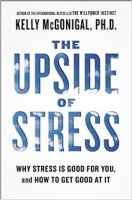 The Upside of Stress: Why Stress Is Good for You, and How to Get Good at It by Kelly McGonigal (Avery, 2015)
The Upside of Stress: Why Stress Is Good for You, and How to Get Good at It by Kelly McGonigal (Avery, 2015)
For a book that has such an important message, and which my read-through has left bristling with sticky notes, this was surprisingly hard to finish. It's equally hard to summarize for this review. I'd hoped that McGonigal's TED talk would be an inspiring summary, so I wouldn't have to say, "read the book." But the talk lacks the details and documentation of the book, and, since it came before the book, lacks several key elements. So I'll say it: "Read the book."
Now, I know that most of you won't, so here's a taste.
Despite everything you've heard, it's not stress that's killing you. What's killing you is believing that stress is killing you. If you see stress as a positive force, it does you no harm. Like grasping the nettle.
Oh, great. So not only is stress killing me, but it's all my fault because I can't make myself pretend it isn't killing me....
Relax. It's not that bad. Really.
As a health psychologist, Kelly McGonigal had made a career out of telling people how bad stress is for their health, and teaching them techniques to help reduce it. But then she came across a study that indicated that by encouraging people to fear and avoid stress, wasn't helping them, but making their lives worse. She might have ignored, or discredited the research, but instead threw herself into investigating this crazy idea, and came away convinced.
In 1998, thirty thousand adults in the United States were asked how much stress they had experienced in the past year. They were also asked, Do you believe stress is harmful to your health?
Eight years later, the researchers scoured public records to find out who among the thirty thousand participants had died. Let me deliver the bad news first. High levels of stress increased the risk of dying by 43 percent. But—and this is what got my attention—that increased risk applied only to people who also believed that stress was harming their health. People who reported high levels of stress but who did not view their stress as harmful were not more likely to die. In fact, they had the lowest risk of death of anyone in the study, even lower than those who reported experiencing very little stress.
The researchers concluded that it wasn't stress alone that was killing people. It was the combination of stress and the belief that stress is harmful. The researchers estimated that over the eight years they conducted their study, 182,000 Americans may have died prematurely because they believed that stress was harming their health.
... According to statistics from the Centers for Disease Control and Prevention, that would make "believing stress is bad for you" the fifteenth-leading cause of death in the United States, killing more people than skin cancer, HIV/AIDS, and homicide.
But there's good news: very small changes can have a great effect on how we look at stress. A brief lecture on the benefits of stress, ten minutes spent writing about what values we find important; such brief interventions have been shown again and again to have long-lasting effects. This isn't a think-and-get-rich plan, nor a placebo effect, but more of a butterfly effect.
[T]o many, these results sound more like science fiction than science. But mindset interventions are not miracles or magic. They are best thought of as catalysts. Changing your mindset puts into motion processes that perpetuate positive change over time.
A belief with this kind of power goes beyond a placebo effect. This is a mindset effect. Unlike a placebo, which tends to have a short-lived impact on a highly specific outcome, the consequences of a mindset snowball over time, increasing in influence and long-term impact.
I'm very bad at doing the "exercises at the end of the chapter" in any book, but even so, simply reading through this one has already made a difference in my life. How much remains to be seen, but the butterfly has flapped its wings, and I'm looking forward to seeing what happens.
And now for the quotes. Extensive, yes, but I'm still leaving too much out. If you can get the book from a library, as I did, it will be well worth your while; it's repetitive enough that you can skim and get the major points. Is it worth $13 for the Kindle version? I don't know; maybe it depends on how stressed you are.... (More)

